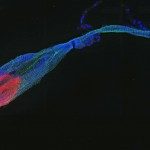Link to Pubmed [PMID] – 2062325
Mol. Immunol. 1991 Apr-May;28(4-5):523-31
Recent studies have shown that the antigenic determinant recognized by a monoclonal antibody (mAb 164-2) elicited against the beta 2 subunit of E. coli tryptophan synthase is localized between residues 276 and 297 of this protein. In order to delineate more precisely the epitope recognized by this antibody, peptides ranging in length from 11 to 29 amino acids and belonging to this region were synthesized, and their interactions with the antibody are described in this paper. The smallest peptide recognized with a high affinity by antibody 164-2 contains 11 residues (273-283). This peptide is recognized by antibody 164-2 with an affinity (KD = 7.5 x 10(-9) M) very close to that of the native beta 2 subunit, suggesting a high structural similarity of the epitope inside the protein and in the isolated peptide. The corresponding sequence of beta 2 is located in a region protruding from the protein surface that contains a beta-turn as unique element of secondary structure in the crystallographic model. The absence of interaction between antibody 164-2 and the octapeptide lacking the three residues at the C-terminal end of peptide 11 suggests that the beta-turn is important in the recognition by the antibody. Kinetic studies were performed to find out whether or not the binding of the antibody to the peptide involves any conformational adaptation. The dissociation equilibrium constant (KD), the dissociation rate constant (koff) and the association rate constant (kon) were measured for eight peptide/antibody complexes. The values obtained were compatible with a one-step reaction, suggesting that no important conformational adaptation is involved in the formation of the peptide/antibody complexes. Furthermore, it has been shown that differences in affinity of antibody 164-2 for the various peptides were mainly due to differences in the dissociation rate constants (koff) and not in the association rate constants (kon). The exceptional location of the epitope in the native protein and the unusually high affinity of the 11-residue peptide for mAb 164-2, makes this peptide a good model for studying the interaction between an antibody and a continuous epitope of a protein.
